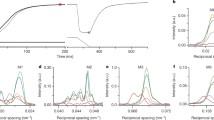Summary
Fibres of frogs sartorius were extracted with glycerol and stored for up to 2 months at −16°C without losing their contractility, while the calcium-sensitivity was partly lost during longer storage. Freshly glycerinated (fully calcium-sensitive) fibres were suspended in ATP-salt-solution with 10−7–10−6 M Ca++ and fibres with partially lost calcium-sensitivity (older than 2 months) were suspended in calcium-free ATP-salt-solution (10−8 M Ca++).
Quick stretch by 0.1–1% of the fibre length caused an immediate tension rise followed by a small tension fall and a secondary delayed tension rise. The maximum tension, but not its kinetics decreased with decreasing actin-myosin-overlap (range 2.2–3 μm). After quick release the immediate tension fall was often followed by a small tension recovery passing into a delayed tension fall. Calcium was not essential for the delayed tension production if the fibres were aged or suspended at pH 8.
During sinusoidal length changes (0.1–1%L 0; 4–45 c/s) the sinusoidal tension changes lagged behind, so that the fibres produced positive work, which was maximum at the frequency of 20 c/s.
Similar content being viewed by others
Literatur
Armstrong, C. F., Huxley, A. F., Julian, F. J.: Oscillatory responses in frog skeletal muscle fibres. J. Physiol. (Lond.)186, 26 P (1966).
Auber, J., Couteaux, R.: L'attache des myofilaments secondaires au niveau de la strie Z dans les muscles des Diptères. C. R. Acad. Sci. (Paris)254, 3425–3426 (1962).
Bárányi, M.: ATP-ase activity of myosin correlated with speed of muscle shortening. J. gen. Physiol.50, 197–218 (1967).
Brocke, H. H. v.: The activating effects of calcium ions on the contractile systems of insect fibrillar flight muscle. Pflügers Arch. ges. Physiol.290, 70–79 (1966).
Caldwell, P. C., Portzehl, H., Rüegg, J. C.: The dependance of contraction and relaxation of muscle fibres from the crabMaja squinado on the internal concentration of free calcium ions. Biochim. biophys. Acta (Amst.)79, 581–591 (1964).
Gordon, A. M., Huxley, A. F., Julian, F. J.: The variation in isometric tension with sarcomere length in vertebrate muscle fibres. J. Physiol. (Lond.)184, 170–192 (1966).
Heinl, P., Sawaya, T.: (in Vorbereitung).
Hotta, K., Bowen, W. J.: Contraction and ATP-ase activity of glycerinated muscle fibres and myofibrillar fragments. Amer. J. Physiol.218, 332–337 (1970).
Huxley, A. F., Simmons, R. M.: Proposed mechanism of force generation in striated muscle. Nature (New Biol.)233, 533–538 (1971).
Jewell, B. R., Rüegg, J. C.: Oscillatory contraction of insect fibrillar muscle after glycerol extraction. Proc. roy. Soc. B164, 428–459 (1966).
Julian, F. J.: The effect of calcium on the force-velocity relation of briefly glycerinated frog muscle fibres. J. Physiol. (Lond.)218, 117–145 (1971).
Machin, K. E., Pringle, J. W. S.: The physiology of insect fibrillar muscle: III. The effect of sinusoidal changes of length on a beetle flight muscle. Proc. roy. Soc. B152, 311–330 (1960).
Mannherz, H. G.: ATP-Spaltung und ATP-Diffusion in oscillierenden extrahierten Muskelfasern. Pflügers Arch.303, 230–248 (1968).
Meinrenken, W.: Calciumionen-unabhängige Kontraktion und ATP-ase bei glycerinierten Muskelfasern nach alkalischer Extraktion von Troponin. Pflügers Arch.311, 243–255 (1969).
Pringle, J. W. S.: Evidence from insect fibrillar muscle about the elementary contractile process. J. gen. Physiol.50, 139–156 (1967).
Pringle, J. W. S.: Mechano-chemical transformation in striated muscle. In: Aspects of cell motility, vol. XXII, pp. 67–86 (1968).
Reedy, M. K., Holmes, K. C., Tregear, R. T.: Induced changes in orientation of the crossbridges of glycerinated insect flight muscle. Nature (Lond.)207, 1276–1280 (1965).
Rüegg, J. C.: Smooth muscle tone. Physiol. Rev.51, 201–248 (1971).
—, Stumpf, H.: Activation of myofibrillar ATPase activity by extension of glycerolextracted insect fibrillar muscle. Pflügers Arch.305, 34–46 (1969).
—, Steiger, G. J., Schädler, M.: Mechanical activation of the contractile system in skeletal muscle. Pflügers Arch.319, 139–145 (1970).
Schädler, M.: Proportionale Aktivierung von ATPase-Aktivität und Kontraktionsspannung durch Calciumionen in isolierten contractilen Strukturen verschiedener Muskelarten. Pflügers Arch.296, 70–90 (1967).
—, Steiger, G. J., Rüegg, J. C.: Tension transients in glycerol-extracted fibres of insect fibrillar muscle (Lethocerus maximus). Experientia (Basel)25, 942 (1969).
Steiger, G. J.: Stretch activation and myogenic oscillation of isolated contractile structures of heart muscle. Pflügers Arch. (in press).
—, Rüegg, J. C.: Energetics and “efficiency” in the isolated contractile machinery of an insect fibrillar muscle at various frequencies of oscillation. Pflügers Arch.307, 1–21 (1969).
Zieger, W. W.: Magnesium und die Hemmung der Actin-Myosin-Interaktion in isolierten contractilen Strukturen der fibrillären Insektenmuskeln. Pflügers Arch.311, 256–264 (1969).
Author information
Authors and Affiliations
Rights and permissions
About this article
Cite this article
Heinl, P. Mechanische Aktivierung und Deaktivierung der isolierten contractilen Struktur des Froschsartorius durch rechteckförmige und sinusförmige Längenänderungen. Pflugers Arch. 333, 213–226 (1972). https://doi.org/10.1007/BF00592684
Received:
Issue Date:
DOI: https://doi.org/10.1007/BF00592684




